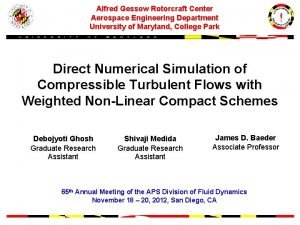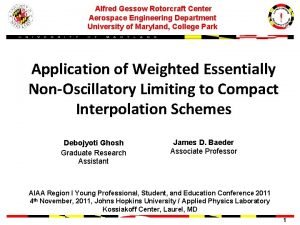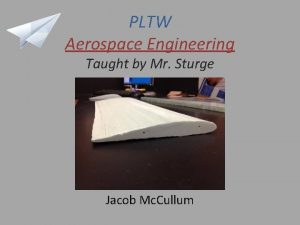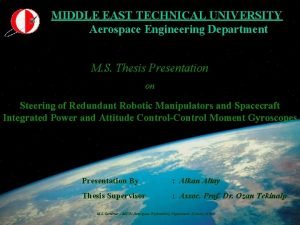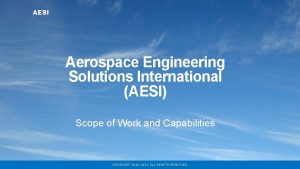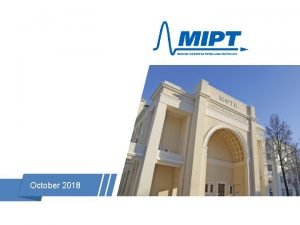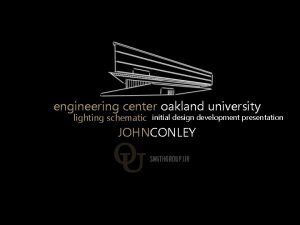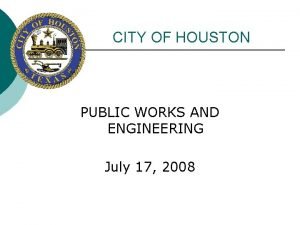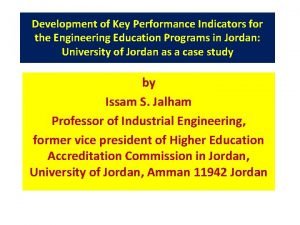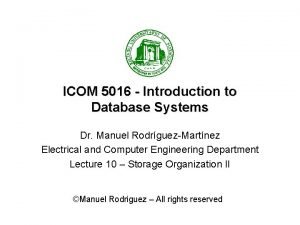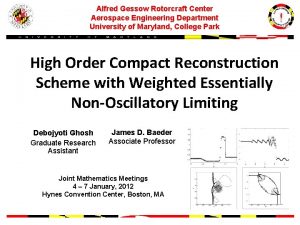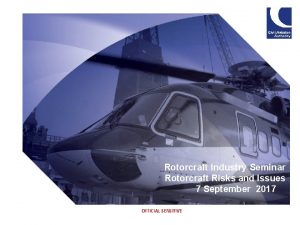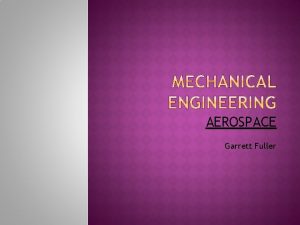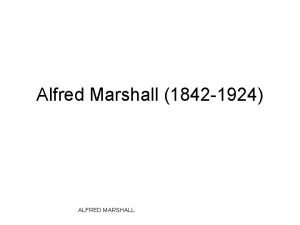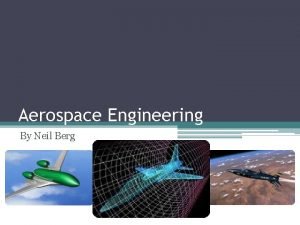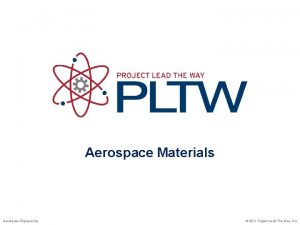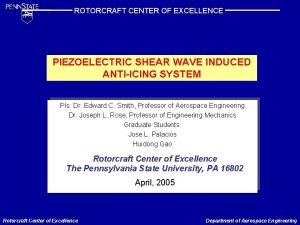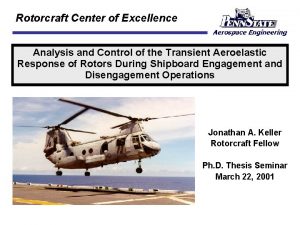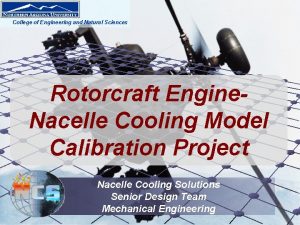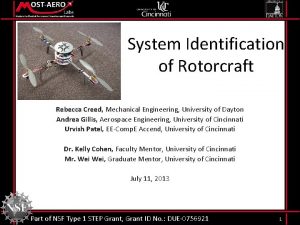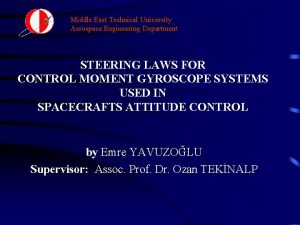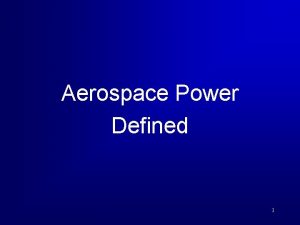Alfred Gessow Rotorcraft Center Aerospace Engineering Department University




















- Slides: 20

Alfred Gessow Rotorcraft Center Aerospace Engineering Department University of Maryland, College Park Application of Weighted Essentially Non-Oscillatory Limiting to Compact Interpolation Schemes Debojyoti Ghosh Graduate Research Assistant James D. Baeder Associate Professor AIAA Region I Young Professional, Student, and Education Conference 2011 4 th November, 2011, Johns Hopkins University / Applied Physics Laboratory Kossiakoff Center, Laurel, MD 1

Motivation and Objectives Accurate numerical simulation of the wake flow field around a rotorcraft – Long term convection and mutual interaction of vortices – Interactions of vortices with fuselage and ground plane High order accurate Stokes solver Navier- – Lower dissipation to preserve vortices as they convect over large distances – Smaller stencil for same order of accuracy to reduce data transfer costs for multiple-mesh solutions 2

Introduction • Scalar hyperbolic partial differential equation • Discretization in time leads to an ordinary differential equation (solved by Euler explicit or TVD RK 3) • Reconstruction – interpolation of f at the interfaces from the cell centered/averaged values • Upwinding – biased interpolation stencil to model wave nature of the solution 3

Compact Schemes • High order accuracy with smaller stencils • Better spectral resolution than explicit interpolation • Lower dissipation at well-resolved frequencies • Taylor series error order of magnitude lower 4

Compact-Reconstruction WENO Schemes • Convex combination of candidate r-th order accurate stencils • Weights of each stencil based on “smoothness” (measured by divided differences of the appropriate order) Optimal Weights WENO Weights • Traditional WENO schemes use explicit interpolation – Higher order accuracy wider stencil oscillatory solutions • Compact-Reconstruction (CRWENO) schemes constructed by using implicit interpolations as candidates in the WENO algorithm – Advantages of compact interpolation schemes (smaller stencil, lower dispersion and dissipation, lower absolute errors) – Non-oscillatory reconstruction across discontinuities 5

Example: CRWENO 5 6

Smoothness Indicators Weights are calculated based on smoothness indicators of corresponding explicit stencils (same as WENO 5 scheme) 7

Linear Advection Equation • • 5 th order convergence with lower absolute error than WENO 5 Less smearing and clipping than WENO 5 8

Inviscid Burgers Equation • Initial sinusoidal solution turns into a shock wave (non-linear flux) • 5 th order convergence (before shock formation) with lower absolute error than WENO 5 9

Extension to the Euler Equations • Compressible Euler equations in 1 D given by • In the form of a general hyperbolic PDE • Extension of interpolation schemes for scalar quantities to a system of equations – Component-wise reconstruction of conservative variables (ρ, ρu, e) – Reconstruction of primitive (flow) variables (ρ, u, p) – Reconstruction of characteristic variables 10

Characteristic-based Reconstruction Characteristic based reconstruction respects the physics of the problem – 1 D scalar wave propagation along each characteristic For interface j+1/2, characteristic quantities are given by i i+1 Reconstruct Uavg (Roe averaged) Upwinding (Roe-Fixed) Eigenvalues, left and right eigenvectors Flux in conservative form 11

CRWENO 5 for 1 D Euler Equations • Scalar interpolation scheme applied to the characteristic variables k = 1, 2, 3 • • Results in a block tri-diagonal linear system along each dimension (as compared to tri-diagonal system for component -wise reconstruction) For multi-dimensions, solution of linear system required along each grid line 12

Entropy Wave • Smooth problem involving the convection of an entropy wave – Density wave convects without dissipation, constant velocity and pressure • • Exact solution given by Periodic boundary conditions enforced on both boundaries Solution compared after one pass over the domain Errors and order of convergence compared – Lower absolute errors for CRWENO 5 at same order of convergence 13

1 D Riemann Problems RF CD S • Initial condition consists of two states separated by a thin partition • Initial discontinuity is decomposed into a rarefaction wave (RF), a contact discontinuity (CD) and a shock wave (S) – Sod’s shock tube problem – Lax’s shock tube problem • Benchmark cases for code validation • Require robust solvers to prevent spurious oscillations 14

Sod’s Shock Tube Comparison of different reconstruction methods Comparison of WENO 5 and CRWENO 5 • Characteristic – based reconstruction yields non-oscillatory results (though computationally more expensive) • Low dissipation of CRWENO 5 results in sharper resolution of shock and contact discontinuity 15

Lax’s Shock Tube Conservative Variable Reconstruction Characteristic-based Reconstruction • Oscillations caused by reconstruction of conservative and primitive variables • CRWENO 5 shows less smearing of shock and contact discontinuity 16

Shock-Entropy Interaction • Interaction between a shock wave and an entropy wave – Solution contains discontinuity and high-frequency waves • Initial condition consists of right-moving shock and density wave • Extrapolation boundary conditions enforced on both boundaries • “Fine Grid Solution” obtained with WENO 5 on 2000 point grid • CRWENO shows lower dissipation and clipping of highfrequency waves 17

Isentropic Vortex Convection (Euler 2 D) Y-Velocity after 1 cycles over the domain Pressure after 1 and 5 cycles over the domain • Convection of an isentropic vortex on a periodic domain • Results shown for a 40 x 40 grid with WENO 5 and CRWENO 5 • Lower dissipation of CRWENO 5 preserves vortex for long–term convection 18

Conclusions and Future Work • Benefits of using the Compact-Reconstruction WENO scheme – Smaller stencil for same order of convergence, lower absolute errors – Lower dissipation leads to better resolution of discontinuities and better long-term convection properties – Computational expense at same grid size is marginally more but coarser grids can be used for same error in solution • Characteristic vs. Component-wise reconstruction – Characteristic reconstruction is costlier, even more so for implicit reconstruction schemes (block tri-diagonal solver) – More robust since physically more accurate – non-oscillatory results for sharp discontinuities – Results similar in case of smooth flows • Implementation of CRWENO for multi-dimensions – 2 D and 3 D Navier-Stokes solvers – Application to airfoil cases, including pitching and plunging airfoils – Simulation of flow field in a rotorcraft wake (convection and interaction of wake vortices) 19

End 20
 Alfred gessow rotorcraft center
Alfred gessow rotorcraft center Alfred gessow rotorcraft center
Alfred gessow rotorcraft center Department of information engineering university of padova
Department of information engineering university of padova Department of information engineering university of padova
Department of information engineering university of padova University of sargodha engineering department
University of sargodha engineering department Pltw aerospace engineering
Pltw aerospace engineering Metu aerospace engineering
Metu aerospace engineering Aerospace engineering solutions
Aerospace engineering solutions Phystech international
Phystech international Aerospace engineer spacex salary
Aerospace engineer spacex salary Oakland
Oakland Electrical engineering department
Electrical engineering department Engineering department in hotel
Engineering department in hotel City of houston design manual
City of houston design manual What is kpi in engineering
What is kpi in engineering Tum
Tum Dmse
Dmse University of bridgeport computer science
University of bridgeport computer science University of bridgeport computer science
University of bridgeport computer science Computer engineering department
Computer engineering department Ucla electrical engineering department
Ucla electrical engineering department
